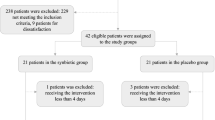Abstract
This study was undertaken to determine the changes in basic nutritional indices associated with major colonic surgery accompanied by periods of semi-starvation. Changes in weight serum albumin, nitrogen balance, and maximum exercise capacity were studied. Weight loss was 5.5±1 per cent, serum albumin decreased 0.20±0.15 gm per cent. Nitrogen loss was 5.9±0.9 gm per day and maximum exercise capacity decreased by 13.5±1.8 per cent. Nitrogen balance improved when amino acids were substituted for glucose as the maintenance regimen, but no corresponding improvement in exercise performance could be demonstrated. It is concluded that major colonic surgery associated with moderate periods of semi-starvation is associated with an average nitrogen loss of 5.9±0.9 gm per day and a 13.5±1.8 per cent loss in maximum exercise capacity or effective muscle mass.
Similar content being viewed by others
References
Moore FD. Metabolic care of the surgical patient. Philadelphia: WB Saunders, 1959:25–48.
Kirk PL. Kjeldahl method for total nitrogen. Anal Chem 1950; 22:354–8.
Archibald RM. Nitrogen by the Kjeldahl method. In: Seligan D, ed. Standard methods of clinical chemistry. New York: Academic Press, 1958;2:91–9.
Wood CD, Shizgal HM. Exercising blood lactates as a measure of maximum work capacity. Clin Res 1977;25:569A.
Wood CD. Postoperative exercise capacity following nutritional support with hypotonic glucose. Surg Gynecol Obstet 1981; 152:39–44.
Tui C, Wright AM, Mulholland JH, et al. Studies on surgical convalescence. Ann Surg 1944;120:99–105.
Russell DM, Lester LA, Whitwell J, Marliss E, Jeejeebhoy KN. Skeletal muscle function during hypocaloric diets and fasting: a comparison with standard nutritional assessment parameters. Am J Clin Nutr 1983;37:133–8.
Shreck R, Tommey R, Towsley K, et al. Relative preservation of functional muscle mass by glucose and amino acids. Clin Res 1984;32:236A.
Wood CD, Shreck R, Tommey R, et al. The relative value of glucose and amino acids in preserving exercise capacity in the postoperative period. Am J Surg (In press.)
Liaw KY, Askanazi J, Michelsen CB, Furst PF, Elwyn DH, Kinney JM. Effect of postoperative nutrition on muscle high energy phosphate. Ann Surg 1982;195:12–8.
Blackburn GL, Flatt JP, Clowes GH Jr, O'Donnell TF, Hensle TE. Protein sparing therapy during periods of starvation with sepsis or trauma. Ann Surg 1973;177:588–93.
Author information
Authors and Affiliations
Additional information
Supported by grants from the Veterans Administration.
About this article
Cite this article
Guess, C.W., Werth, R., Pollard, M. et al. An assessment of nutritional depletion following major colonic surgery. Dis Colon Rectum 27, 669–671 (1984). https://doi.org/10.1007/BF02553362
Received:
Issue Date:
DOI: https://doi.org/10.1007/BF02553362




